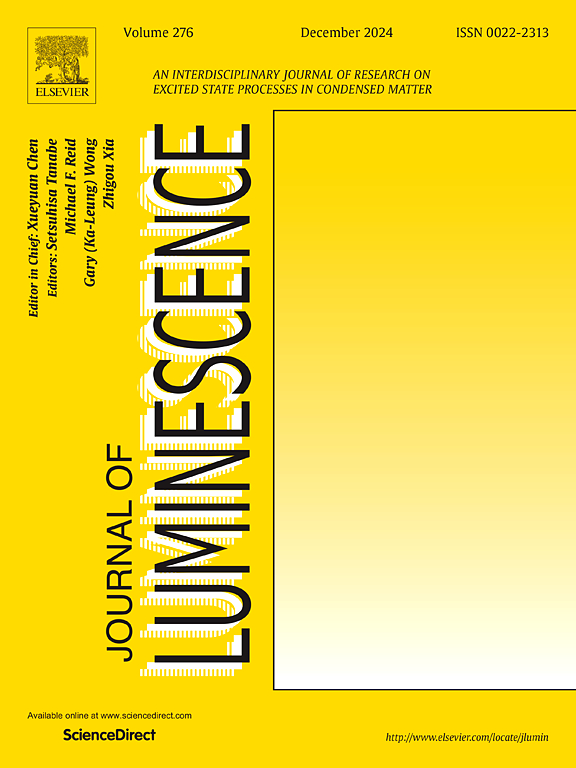Luminous thermal stability and versatile applications of red emitting Ba3Y4O9: Eu3+ phosphor in W-LEDs, forensic science and security technologies
IF 3.3
3区 物理与天体物理
Q2 OPTICS
引用次数: 0
Abstract
A red-emitting Ba3Y4O9: Eu3+ (BYO: Eu3+) phosphors are synthesized via cost effective solution combustion method. The phase structure of the synthesized phosphor is analyzed through X-ray diffraction (XRD) with Rietveld refinement, complemented by field emission scanning electron microscopy (FE-SEM) and X-ray photoelectron spectroscopy (XPS). Photoluminescence (PL) studies of BYO: 3Eu3+ revealed strong orange-red emission peaks centered at 586 nm and 614 nm under 392 nm deep ultraviolet excitation. The optimal doping concentration is determined to be 3 mol%, beyond which concentration quenching is observed. The BYO: 3Eu3+ phosphor exhibited remarkable thermal stability, maintaining 85 % of its luminescence intensity at 420 K, with an activation energy (Ea) of 0.375 eV. The quantum efficiency is assessed using an integrating sphere, yielding an internal quantum efficiency (IQE) of 91.3 %. The fabricated white light emitting diode (w-LED) achieved a correlated color temperature (CCT) of 4952 K, an impressive color rendering index (CRI) of 92, and Commission Internationale de l’Éclairage (CIE) chromaticity coordinates of (0.346, 0.348). Additionally, BYO: 3Eu3+ demonstrated effective visualization of level I–III LFP structures under ultraviolet illumination, facilitating forensic detection in various real-world applications. These findings underscore the significant potential of BYO: 3Eu3+ phosphors for w-LEDs lighting, forensic fingerprint analysis, and anticounterfeiting technologies.

红色发光Ba3Y4O9: Eu3+荧光粉在w - led,法医科学和安全技术中的发光热稳定性和广泛应用
采用低成本的溶液燃烧法合成了Ba3Y4O9: Eu3+ (BYO: Eu3+)发红荧光粉。利用Rietveld细化的x射线衍射(XRD)、场发射扫描电镜(FE-SEM)和x射线光电子能谱(XPS)分析了合成荧光粉的相结构。在392 nm深紫外激发下,BYO: 3Eu3+的光致发光(PL)显示出以586 nm和614 nm为中心的强橘红色发射峰。确定最佳掺杂浓度为3mol %,超过该浓度会出现猝灭现象。BYO: 3Eu3+荧光粉表现出良好的热稳定性,在420 K下保持85%的发光强度,活化能(Ea)为0.375 eV。利用积分球对量子效率进行了评估,得到了91.3%的内量子效率(IQE)。制备的白光发光二极管(w-LED)的相关色温(CCT)为4952 K,显色指数(CRI)为92,国际委员会Éclairage (CIE)的色度坐标为(0.346,0.348)。此外,BYO: 3Eu3+在紫外线照射下有效地显示了I-III级LFP结构,促进了各种实际应用中的法医检测。这些发现强调了BYO: 3Eu3+荧光粉在w- led照明、法医指纹分析和防伪技术方面的巨大潜力。
本文章由计算机程序翻译,如有差异,请以英文原文为准。
求助全文
约1分钟内获得全文
求助全文
来源期刊

Journal of Luminescence
物理-光学
CiteScore
6.70
自引率
13.90%
发文量
850
审稿时长
3.8 months
期刊介绍:
The purpose of the Journal of Luminescence is to provide a means of communication between scientists in different disciplines who share a common interest in the electronic excited states of molecular, ionic and covalent systems, whether crystalline, amorphous, or liquid.
We invite original papers and reviews on such subjects as: exciton and polariton dynamics, dynamics of localized excited states, energy and charge transport in ordered and disordered systems, radiative and non-radiative recombination, relaxation processes, vibronic interactions in electronic excited states, photochemistry in condensed systems, excited state resonance, double resonance, spin dynamics, selective excitation spectroscopy, hole burning, coherent processes in excited states, (e.g. coherent optical transients, photon echoes, transient gratings), multiphoton processes, optical bistability, photochromism, and new techniques for the study of excited states. This list is not intended to be exhaustive. Papers in the traditional areas of optical spectroscopy (absorption, MCD, luminescence, Raman scattering) are welcome. Papers on applications (phosphors, scintillators, electro- and cathodo-luminescence, radiography, bioimaging, solar energy, energy conversion, etc.) are also welcome if they present results of scientific, rather than only technological interest. However, papers containing purely theoretical results, not related to phenomena in the excited states, as well as papers using luminescence spectroscopy to perform routine analytical chemistry or biochemistry procedures, are outside the scope of the journal. Some exceptions will be possible at the discretion of the editors.
 求助内容:
求助内容: 应助结果提醒方式:
应助结果提醒方式:


